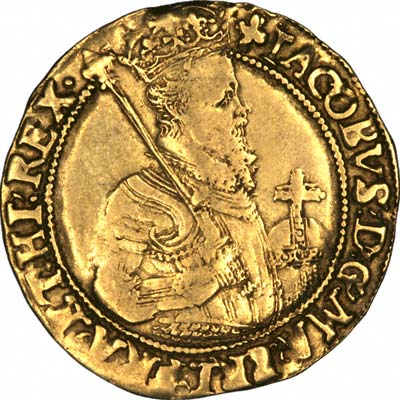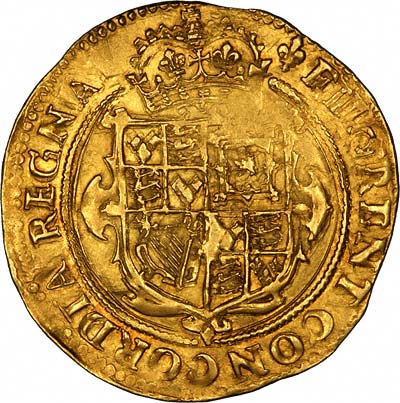| The Very Highest Quality Gold Unites |
| The History and Story of the Gold Unite |
|
 |
 |
 |
 |
From Tudor to Stuart
The ascension of James VI of Scotland to the English throne followed the death of Queen Elizabeth and the end of the Tudor monarchy in 1603. This event brought a substantial dynastic and political change to the English infrastructure and his unpopularity south of the border in effect laid the foundations for the problems that would leave his son with an internal uprising, a civil war, and eventually the loss of his head.
The First 'King of Great Britain?'
Before all these ramifications, some of which we shall touch upon through the story of the Unite; it comes as little surprise that the Unite came to pass under the name it did when one considers the kind of monarch James was. In effect he was the first monarch who consciously styled himself as 'The King of Great Britain,' and through the 'Unite' he was implying an intention of unifying of the two countries, which didn't occur until an act of parliament in 1707. There is no doubting his extensive intellect, in fact he is considered one of the wisest men ever to sit on the English or Scottish thrones, but his intellect and position seemed to combine in a very counterproductive manner, leading him to be known as 'The wisest fool in Christendom!'
James I as the Original Spin Doctor?
The first gold coinage under James I (1603-04) was in effect the same as had existed since the beginning of the Tudor Dynasty under Henry VII, with a Sovereign worth 20 shillings and Half Sovereign worth ten. It is probably no coincidence that the Tudor self styled sovereign disappeared from the English coinage for over 200 years within twelve months of James I claiming the throne as the establishment of a new monarchical house often leads to 'dramatic' changes to establish the new ruling dynasty.
James I Second Coinage
The second gold coinage minted under James I came to pass very quickly indeed. It seems a great bit of 'public relations' that the Sovereign was re-christened as a 20 shilling or £1 Unite as the new monarch attempted to consolidate his position and make clear his intentions. There seems little doubt that the new English monarch would have had a large part to play in this knowing his character, and just as the sovereign had portrayed the monarch in a grand posture on the throne, the first Unite had probably the largest bust of any monarch depicted on the obverse (with sceptre and orb) in the then history of the English coinage; since the move away from the representational image of the monarch that existed for centuries.
Short Stories and Inflation
If you were to read 'The Story of the Five Guinea piece' then you would see that this coin had a remarkably short existence in relation to its fame, however the Unite was only minted between 1604 and 1662, and by no means was this production ever constant. There were only three types minted under James I during the second coinage, with a variety of busts used. However, due to the value of all the gold coins being raised by 10% in 1612, the Unite was re-valued at 22s. This meant that by the time of the third gold coinage the Unite was replaced by a new, lighter 20-shilling Laurel and no more 'Unites' were minted during his reign.
Changing Faces
It is more than worth mentioning as a footnote to the coinages' of James I that something occurred during his reign that we aren't aware happened under any other monarch. For reasons of tradition more than anything, since representational images of the monarch were supplanted by actual portraits with the introduction of the shilling under Henry VII, the direction the monarch faces alternated with each reign. This continued right through the ages and has done so right up until the several portraits of our present queen, all facing the same way. The only exception being the largely Uncirculated coinage of Edward VIII, who apparently for reasons of vanity wanted to be portrayed facing to the left, the same way as his father George V had done What is remarkable about the portraits of James I is that the portrait actually changes the way it faces during his reign, the third coinage showing a 'Romanesque' laurel bust which faced to the left rather than the right as the first two coinages had done. Although this would restore itself later on in his reign, we have no idea what the reason for this is, and would welcome any input on this issue! In fact, if we consider as James I did that English kings were 'Little Gods on earth,' then maybe the answer will arrive via a higher source?
Charles I and Briot's Milled Coinage
The coinages of Charles I can become a minefield when one gets into the vast and varied coinages issued by the emergency mints established throughout the country. For the first coinage minted under this reign in 1625 the Unite appeared again as a 20-shilling £1 gold coin. For the first time, the denomination of the Unite had a figure 'XX' on the obverse besides the portrait of Charles to denote a value of 20-shillings. Although in general the Unite is regarded as a hammered coin, there is one type that was produced via machine striking in 1631-32. Nicholas Briot, the brilliant French diesinker, was responsible for this, but at the time the process was still slower than 'hand hammering' coins and so a hammered Unite re-appeared in the 'Briot's Hammered Issue' of 1638-39.
Three Civil Wars
After this issue, the English coinage in general, as already mentioned, becomes a detailed and complex story during the Civil Wars (an intentional plural, many people seem to forget there were three separate wars!) as some strange shapes and designs of coins appeared. While we won't trawl through all of this, it is worth mentioning the rather crude Chester Mint Unite of 1644 and especially one of the most famous coins in the English Hammered Gold series, the Oxford mint Triple Unite, the largest gold coin ever produced. Certain types of these in good condition can fetch well over £50,000 at auction.
Cromwell and the Commonwealth
In a similar way that James I replaced the sovereign with the Unite, one would have thought that following the execution of Charles I and the installation of the commonwealth from 1649-60 that Cromwell and his associates would want to discontinue issuing a £1 gold coin under the 'Unite' prefix. Although they may have believed in the gesture and reasoning behind the coin being called 'The Unite,' it seems slightly strange that they didn't alter a name so associated with the Stuart Monarchy. What is even stranger is that the period of The Commonwealth saw the most regular production of the coin in its short history; it being minted every year from 1649 until 1660 with the exception of 1659. To be precise as to who exactly was ruling England at which point during this period, the republican government of the 'Commonwealth of England' ruled England (and later all of Scotland and Ireland) from 1649 to 1653 and from 1659 to 1660. Between the two periods, and due to in-fighting amongst various factions in Parliament, Oliver Cromwell ruled over the protectorate as Lord Protector (effectively a military dictator) until his death in 1658 from malaria.
Pomp and Circumstance
As with most Commonwealth coins, the move away from the Latin pomp and ceremony associated with the heritage of the English monarchy made the coins a lot less aesthetically pleasing as they were previously. For all of these Commonwealth issues, the inscriptions were in English and there was no portrait on either the obverse or reverse. The Royal arms were changed to encompass the cross of St. George and the Irish harp.
Cromwell's Downfall and the Unite Restoration
Although the milled Cromwell coins are quite valuable and it's not certain whether the 1656 issues were merely patterns or intended for general circulation, what is certain is that the 20-shilling gold piece minted with Cromwell's portrait was called 'The Broad,' so maybe the long term intention was to move away from the Stuart 'Unite' to a newly named coinage specific to Cromwell and the Protectorate? However, all of this quickly became quite hypothetical for both Cromwell's Republican ruling and the way in which English coins would be minted from then onwards. Following Cromwell's death, his son Richard took his place, but he was a man whom the army had little confidence in. Within 18 months, the country had nearly descended into anarchy until on the 4th April 1660 in the Declaration of Breda, Charles II (who had been in exile for the past eleven years) made known his terms and conditions for the acceptance of the throne of England and the restoration of the monarchy followed soon after.
False Dawn - No Marks!
In an almost false new dawn, the first hammered coinage of Charles II 'restored' the 'Unite' to it's rightful position as the 20-shilling £1 gold coin, though this time the mark of value was not present. However, this would be the last ever issue of a £1 gold coin under the name of 'The Unite.' Early in 1663, the ancient process of hammering coins by hand was finally superseded (after many false starts over the past 100 years or so) by machinery that worked efficiently and faster than hammering. With the advent of Milled coinage, many of the old denominations and designs disappeared in an attempt to bring in a new order and a break from the rather uncomfortable previous 60 years or so that the Unite had been a part of. It would be replaced by a Guinea, which, while later would be valued at 21-shillings, was originally installed as a direct replacement 20-shilling £1 gold coin.
The End of the Line
The age of the Unite was over. A coin whose existence lasted barely half a century; its history bears witness to the most troublesome and unstable time in English history since the Norman conquest of 1066. For this reason alone, the story of the Unite remains a fascinating story to tell as it encompasses more stories of trouble, egomania, war, death and politics in one human lifetime than many English coins would manage over a lifespan of several centuries.
The Story of the Gold Sovereign
If you are interested in the history of the British gold sovereign, this is
available on our other specialist website
goldsovereigns.co.uk
.
If you want to find the value of a coin you own, please take a look at our page I've Found An Old Coin, What's It Worth?
If you have an enquiry about any of our gold guineas we'd be happy to try to answer you, but do please ensure you look at our other information pages before asking a generalised question.
| ...at the Lowest Possible Price |
|
32 - 36 Harrowside, Blackpool, Lancashire, FY4 1RJ, England.
Telephone (44) - (0) 1253 - 343081 ; Fax 408058; E-mail: The URL for our main page is: https://24carat.co.uk |
Web Design by Snoop |